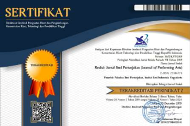Sasandu Gong and Sasando Violin: Changing the Pentatonic Scales to Diatonic
Abstract
This study aims to determine the main causes of changes in the scales that occur. Changes in the scale of the Sasando musical instrument are influenced by mass culture, popular culture and the development of the market industry which has led to the tendency of the people of NTT, especially the city of Kupang to lead to Western lifestyles as if starting to leave local traditions. Values, meanings and social functions of Sasandu Gong are diminished and will even disappear in future generations. The influence of colonialism is assumed to be the cause of the people of Kupang prefer something modern than local wisdom. Some articles, journals, books and even websites often talk about the implementation of local cultural values as a cultural heritage and traditional art which is the identity of the Indonesian people. The author uses the concept of Leela Gandhi and Edward Said in general to discuss efforts to undermine Western hegemony, in which the domination of Western powers over the Eastern world considers the East as weak and full of imagination. The qualitative method is used as an exploratory approach that relies on in-depth data analysis in the form of text obtained from the speakers. The research results are discussed in three (3) stages. First, from the Postcolonial perspective that the change occurred starting from the history of the entry of Christianity into East Nusa Tenggara (NTT) by the Dutch people. Second, musicologically, Sasando Violin experienced the development of scales with several variations made by Mr. Drs. Djony L. K. Theedens. Third, the physicality of the sound of the Sasas Gong changes in shifting functions, values, and meanings that existed before.
Keywords
Full Text:
PDFReferences
Kepustakaan
AdadiKupang.com. (2014). Edon, Habel: Penerus Sasando Elektrik Di Kupang.
Balai Pelestarian Nilai Budaya (BPNB) Bali, NTB, N. (2012). Inventarisasi Perlindungan Karya Budaya Sasandu di Rote Ndao (Pusat Kajian Universitas Udayana (UNUD) Bali (ed.)).
Budi, D. S. U. (2017). Modifikasi Angklung Sunda. Resital : Jurnal Seni Pertunjukan. Journal of Performing Arts, 18.
De Fretes, D. (2016). Soundscape: Musik dan Lingkungan Hidup. Promusika, 4(2), 117–125. https://doi.org/10.24821/promusika.v4i2.2279
Djawa, B. W. (2019). Fungsi Musik Ndoto Dalam Ritual Ngagha Mere. Selonding, 15.
Dowling, T. (2015). Black and White Photographs. Journal of Military History, 79(4), 1059–1077.
Francis, Y. S. (2019). Transmisi Alat Musik Sasando Sebagai Media Seni Budaya Di Kabupaten Rote Ndao Provinsi Nusa Tenggara Timur. UPT Perpustakaan ISI Yogyakarta, 63(May), 9–57. https://doi.org/10.1016/j.chb.2016.05.008
Gandhi, L. (1998). Teori Poskolonial : Upaya Meruntuhkan Hegemoni Barat. Qalam.
Gelu, A., Ulhadi, U., Darsono, T., & Liwa, K. (2017). Pengaruh Bentuk Daun Lontar Terhadap Intensitas Bunyi Alat Musik Sasando. VI, SNF2017-MPS-75-SNF2017-MPS-80. https://doi.org/10.21009/03.snf2017.02.mps.12
Haning, P. (2006). Raja Pendidik dan Penginjil. CV. GUNTUR BERISI PUSTAKA.
Haning, P. (2009). Sasandu, Alat Musik Tradisional Masyarakat Rote Ndao. CV Kairos.
Jutomo, L., Warsito, A., Djati, H., Ismail, E. H., David, C., Edon, H., Lasiana, A., Lima, K., Timur, N. T., Lasiana, J. A., Lima, K., & Timur, N. T. (2019). Peningkatan Kualitas , Promosi dan Diversifikasi Pemasaran Produksi Alat Musik Sasando Tradisional dan Elektrik sebagai Upaya Melestarikan Budaya Lokal Nusa Tenggara Timur. 3(1), 1–9.
Kaet, M. S. I. (2019). Perubahan Organologi dan Kreatifitas Pembelajaran Musik Sasandi di Sanggar Edon Sasando Kupang. UNIVERSITAS NEGERI SEMARANG.
Karti, G. P. (2017). Indikasi Pencitraan dalam Upacara Adat Rebo Pungkasan di Wonokromo Pleret Bantul Yogyakarta. INVENSI, 1(2), 13–23. https://doi.org/10.24821/invensi.v1i2.1612
Koehuan, T. M. H. (2016). Eksplorasi Permainan Gitar Elektrik Pada Lagu Ofa Langga Dalam Ansambel Sasando.
Liliweri, A. (2014). Pengantar Studi Kebudayaan. Nusamedia.
Nasional, M. I. D. (2015). Amerika Serikat : Journal of International Social Research. Social Sciences.
Nusacendanabiz. (2015). Sasando Adalah Sebuah Alat Instrumen Petik Musik.
Ohi, R. (2019). Nilai Organologi Akustik Polopalo. Selonding, 15(1), 35–42.
Pah, Y. E. (2016). Implementasi Nilai-Nilai Budaya Sasandu Dalam Pembelajaran Sejarah Di SMA Kristen Siloam Rote. Universitas Sebelas Maret.
Putra, L. P. (2015). Belu : Sebuah Eksplorasi Musik Nusa Tenggara Timur di Daerah Istimewa Yogyakarta. Ekpresi Seni. Jurnal Ilmu Pengetahuan Dan Karya Seni, 17(1), 20–40.
Raharjana, K. D. T., & Made, P. (2019). Pemberdayaan Masyarakat Di Kawasan Cagar Budaya. Tata Kelola Seni, 5.
Santoso, V. (2016). Akulturasi Estetika Sebagai Modal Untuk Menghadapi Pertukaran Kesenian Dalam Masyarakat Ekonomi Asean. Invesi, 1.
Saputri, L. (2019). Pengaruh Budaya Pandalungan pada Bentuk Penyajian Kesenian Can Macanan Kadduk. Invesi, 4.
Strinati, D. dalam S. S. (2007). Popular Culture : Pengantar Menuju Teori Budaya Populer. JEJAK.
Theedens, D. (2012). Pedoman Permainan Sasando.
Wadie Said, E. (2010). Orientalisme : Menggugat Hegemoni Barat dan Mendudukan Timur Sebagai Subyek. Pustaka Pelajar.
Wijayanto, B. (2015). Strategi Musikal dalam Ritual Pujian dan Penyembahan Gereja Kristen Kharismatik. Resital: Jurnal Seni Pertunjukan, 16(3), 125–140. https://doi.org/10.24821/resital.v16i3.1678
Yasa, I. K. (2000). Sasando (Sebuah Kajian Dari Aspek Argonologis, Musikologis,Dan Kutural). Mudra (Jurnal Seni Budaya), 8, 1–1. http://jurnal.isi-dps.ac.id/index.php/mudra/article/view/641
Yasa, I. K. (2017). Aspek Musikologis Gêndér Wayang dalam Karawitan Bali. Resital: Jurnal Seni Pertunjukan, 17(1), 46–59.https://doi.org/10.24821/resital.v17i1.1689
DOI: https://doi.org/10.24821/resital.v22i1.3728
Refbacks
- There are currently no refbacks.
This work is licensed under a Creative Commons Attribution 4.0 International License.



